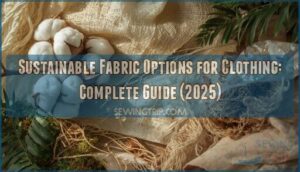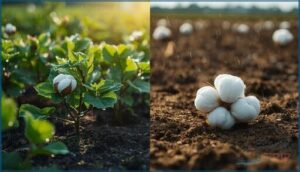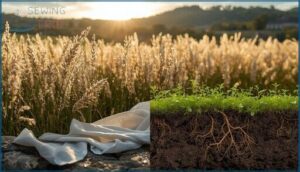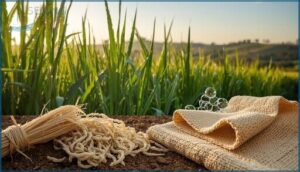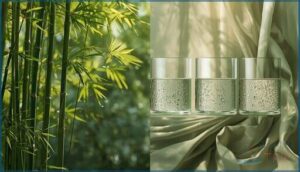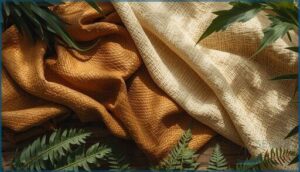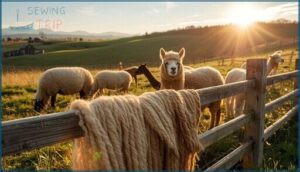This site is supported by our readers. We may earn a commission, at no cost to you, if you purchase through links.
Your wardrobe holds more power than you think—textile manufacturing generates up to 10% of global carbon emissions, and the fabrics touching your skin right now probably started their journey in a chemically intensive factory halfway around the world.
The good news? A quiet revolution in sustainable fabric options for clothing is making it easier to dress consciously without sacrificing style or comfort. From organic cotton that slashes water use to resourceful materials grown from mushrooms and recycled ocean plastic, today’s eco-friendly textiles prove that fashion doesn’t have to cost the earth.
Understanding which fabrics genuinely reduce environmental harm—and which green claims are just marketing smoke—helps you to build a wardrobe that aligns with your values and stands the test of time.
Table Of Contents
- Key Takeaways
- What Makes a Fabric Sustainable?
- Plant-Based Sustainable Fabric Options
- Animal-Based Sustainable Fabrics
- Recycled and Regenerated Synthetic Fabrics
- Semi-Synthetic and Innovative Materials
- Certifications for Sustainable Fabrics
- Choosing and Caring for Sustainable Fabrics
- Frequently Asked Questions (FAQs)
- Conclusion
Key Takeaways
- Textile manufacturing accounts for up to 10% of global carbon emissions, but genuinely sustainable fabrics—verified by certifications like GOTS, OEKO-TEX, and BLUESIGN—reduce environmental harm through lower water use, biodegradability, and closed-loop production systems that recover over 99% of chemicals and solvents.
- Plant-based options like organic cotton, linen, and hemp slash water consumption by up to 91% compared to conventional materials, while innovative fabrics such as TENCEL Lyocell, Piñatex, and recycled polyester (rPET) cut carbon emissions by 46-79% without sacrificing durability or style.
- Extending a garment’s life beyond thirty wears reduces its climate impact by over 60%, meaning proper care—washing less often, air drying, using microfiber filters, and choosing repair over replacement—matters as much as the fabric itself.
- Greenwashing remains prevalent with roughly 39% of sustainability claims potentially false, so you’ll need to look past vague “eco” labels and prioritize third-party certifications, transparent supply chains, and brands that disclose factory locations and material sources.
What Makes a Fabric Sustainable?
Not all fabrics are created equal when it comes to environmental responsibility. A truly sustainable fabric considers everything from how it’s grown or manufactured to the resources it consumes and the waste it creates.
Understanding what sets these materials apart helps you make informed choices that align with your values.
Key Characteristics of Sustainable Fabrics
You’ll recognize truly sustainable fabrics by their fiber durability—lasting beyond thirty wears cuts climate impact by over 60%. Look for biodegradability factors that guarantee natural fibers break down cleanly, chemical safety backed by certifications, and resource efficiency in production. Eco-friendly fabrics also minimize microfiber shedding, especially when you choose cellulosic materials over synthetics.
Truly sustainable fabrics last beyond thirty wears, biodegrade cleanly, meet safety certifications, and shed minimal microfibers during use
These sustainable material selection criteria define what makes fabric genuinely eco-friendly. Fabric selection considerably impacts a garment’s environmental footprint, determining nearly 80% of its overall effect.
Environmental Impact of Fabric Production
Understanding how fabrics are made reveals their true environmental cost. The textile industry contributes 8-10% of global greenhouse gas emissions, while synthetic fibers dominate 64% of production. The sector is a major contributor to global CO2 emissions. Here’s what you’re facing:
- Cotton irrigation can consume 444 m³ of water per kilogram in arid regions
- Synthetic textiles shed 500,000 tonnes of microfibers into oceans annually
- Polyester production emits roughly 9.5 kg CO2 per kilogram of fiber
- Conventional dyeing and finishing drive most water consumption and chemical pollution
- Textile manufacturing accounts for 50-80% of a garment’s total environmental footprint
Importance of Certifications and Standards
You can’t verify a sustainability claim just by looking at fabric on a hanger. That’s why textile certifications matter—they’re your proof against greenwashing. GOTS certification, for instance, bans toxic chemicals and traces supply chains from field to finished product.
Over 50,000 OEKO-TEX certificates were issued in 2023/2024 alone, giving brands market access and building consumer trust through label transparency and nontoxic verification.
Plant-Based Sustainable Fabric Options
Plant-based fabrics offer some of the most sustainable options in fashion, with materials that grow naturally and often require fewer resources than conventional alternatives. From time-tested fibers like organic cotton and linen to new materials made from pineapple leaves and banana plants, these fabrics represent a growing shift toward renewable, biodegradable clothing.
Let’s explore the most practical plant-based options you can look for when building a more sustainable wardrobe.
Organic Cotton Benefits and Challenges
Organic cotton stands as a frontrunner among natural fibers, yet it carries both promise and complexity. A 2014 study found it delivers 46% lower global warming potential than conventional cotton, plus dramatic pesticide reduction—since conventional cotton uses roughly 4% of global pesticides. However, you’ll encounter real trade-offs:
- Soil health improves through composting and crop rotations, boosting water retention
- Water consumption drops up to 91% when rain-fed methods replace irrigation
- Certification costs burden smallholder farmers, complicating economic viability
- Lower yields mean more land is needed to meet demand
GOTS certification ensures transparent, chemical-free production, making organic cotton a sustainable material selection worth your consideration—if you can navigate the price premium and supply-chain challenges.
Linen and Its Eco-Friendly Properties
Flax cultivation gives linen its eco-friendly edge—it needs just 400 liters of water per kilogram versus cotton’s 20,000, and thrives on rainfall in temperate climates.
You’ll appreciate linen’s durability and natural strength, which extend garment lifespans and reduce replacement frequency.
Biodegradability means it decomposes in weeks, not decades, while microfiber shedding poses minimal pollution since cellulosic fragments break down naturally, unlike persistent synthetics.
Hemp as a Renewable Resource
Hemp stands out for its resilience and environmental efficiency. You’ll benefit from choosing organic hemp that delivers tangible resource savings:
- Water Efficiency: uses 300–500 liters per kilogram versus cotton’s 1,800–2,200
- Carbon Sequestration: absorbs 8–15 tonnes CO₂ per hectare
- Fiber Durability: yields 3 tonnes per hectare with greater tensile strength
- Market Growth: projected to reach $8.9 billion by 2030
- Renewable resources: thrives on rainfall alone in many regions
Bamboo and Bamboo Lyocell
When you explore bamboo for sustainable fabrics, you’ll encounter two distinct options: conventional viscose and bamboo lyocell. Bamboo cultivation absorbs roughly 4.5 metric tons of CO₂ per acre annually and requires half the water of tree-based pulp—but viscose impacts include 10,000 liters per kilogram and hazardous chemical discharge.
Bamboo lyocell uses closed-loop processing with 98% solvent recovery, achieving 36% lower carbon emissions than viscose.
Look for fiber certifications like FSC and OEKO-TEX to verify sustainable material selection in plant-based fibers.
Innovative Plant-Based Fabrics (Piñatex, Bananatex)
Beyond familiar plant-based fibers, you’ll discover modern vegan leather alternatives like Piñatex—made from pineapple leaves—which cuts carbon emissions by 90% versus animal leather and earns farmers approximately 2€ per square meter.
Bananatex transforms Abacá stalks into biodegradable fabric with no pesticides required. Both materials carry PETA and Cradle to Cradle certifications, proving plant-based sustainable fabrics can deliver durability while dramatically reducing production impact.
Animal-Based Sustainable Fabrics
Animal-based fabrics like wool and alpaca can be surprisingly sustainable when sourced responsibly, offering durability and natural performance without relying on petroleum. The key lies in how these fibers are produced, what certifications back them up, and whether the animals are treated ethically throughout the process.
Let’s look at the most sustainable animal fiber options and what makes them worth considering for your wardrobe.
Merino Wool and Responsible Sourcing
Merino wool might feel luxurious, but is it truly sustainable? Understanding its wool carbon footprint, animal welfare standards, and land management impact helps you make informed choices. Here’s what responsible sourcing means:
- Certifications like RWS and ZQ guarantee mulesing-free practices and ethical sourcing
- Biodegradability studies show merino breaks down 10x faster than synthetics in marine environments
- Circularity initiatives through recycling reduce methane emissions and resource pressure
Extending your merino garments to 400 wears greatly cuts environmental impacts.
Alpaca and Camel Wool Sustainability
Alpaca wool and camel wool offer compelling animal-based sustainable fabrics when you prioritize ethical herding practices. Alpaca carbon footprint sits at just 0.449 kg CO2e per sweater wear, while their gentle grazing preserves soil better than sheep.
Look for Animal welfare RAS certification—H&M requires it by 2025. Both fibers show excellent fiber biodegradability, though camel land impact raises concerns about overgrazing in fragile ecosystems.
Recycled and Certified Animal Fibers
When animal welfare matters, certifications transform how you source wool and other animal fibers. The Responsible Down Standard and similar programs verify traceability systems from farm to final garment, with certified mohair and cashmere reaching 47% market share in 2023.
Wool recycling dramatically reduces environmental impact:
- Uses 99% less water than virgin production
- Achieves 96% energy savings
- Retains over 92% tensile strength
Global recycled wool hit 73,000 tonnes in 2023, reflecting growing market trends toward verified, responsible merino wool and certified alternatives.
Ethical Considerations in Animal-Based Fabrics
Sourcing animal fibers responsibly requires confronting significant ethical challenges. Approximately 80% of Merino sheep have historically undergone mulesing, an invasive procedure, while around 96% of down production risks live plucking due to opaque supply chains. Cattle ranching for leather drives 80% of Amazon deforestation, and between 420 billion to 1 trillion silkworms are killed annually for silk production. These issues highlight the need for robust traceability standards to verify animal welfare claims.
| Animal Fiber | Primary Ethical Concern |
|---|---|
| Wool | Mulesing alternatives needed; handling issues |
| Down | Live plucking risks in parent farms |
| Leather | Deforestation; worker exposure to toxins |
| Silk | Silkworm suffering; billions killed annually |
Recycled and Regenerated Synthetic Fabrics
You don’t have to choose between synthetic fabrics and sustainability anymore. Advances in recycling and regeneration have transformed plastic waste and discarded materials into high-performance textiles that rival their virgin counterparts.
Let’s look at the key options reshaping how we think about synthetic fabrics.
Recycled Polyester (rPET)
When you choose recycled polyester (rPET), you’re cutting carbon emissions by up to 79% compared to virgin synthetics. Made from post-consumer bottles, rPET production fosters waste reduction and a circular economy.
Chemical recycling technologies are improving quality, though microfiber shedding remains a challenge—rPET textiles release microplastics just like conventional synthetic fabrics, so pairing them with filtration solutions matters.
ECONYL (Recycled Nylon)
ECONYL takes nylon depolymerization a step further—fishing nets, carpet scraps, and industrial waste become brand-new nylon with zero quality loss. You’ll save 7 barrels of crude oil per ton produced, cutting CO2 emissions by up to 90% compared to virgin nylon.
Brands like Stella McCartney integrate ECONYL into luxury pieces, while the global market projects growth from $1.2 billion (2024) to $4.7 billion by 2033—proof that recycled synthetics deliver performance without compromise.
Upcycled Deadstock and Textile Waste
When fashion’s cutting-room floor spills 10–15% of every fabric order, you’re looking at millions of tons of pre-consumer textile waste annually—prime material for upcycling. Deadstock sourcing turns those scraps and surplus rolls into fresh designs, slashing the 92 million tons of waste the industry generates each year.
The upcycled products market hit $8.25 billion in 2024, driven by policy impact like France’s ban on destroying unsold inventory and brands proving waste reduction works.
Closed-Loop Production Processes
When sustainable fabric production eliminates waste by turning every output back into an input, you’re witnessing closed-loop manufacturing processes at their finest. These circular design systems recover chemicals, water, and materials with over 99% efficiency in some lyocell operations, cutting emissions while energy efficiency improvements slash costs:
- Chemical recycling systems recapture solvents for reuse
- Resource recovery transforms textile scraps into new fibers
- Waste stream reduction minimizes landfill-bound materials
- Circular manufacturing closes gaps between production and disposal
Semi-Synthetic and Innovative Materials
Semi-synthetic fabrics sit at the intersection of natural materials and modern innovation, transforming wood pulp and agricultural byproducts into some of fashion’s most sustainable textiles. These fabrics use closed-loop systems that recover and reuse chemicals, dramatically reducing environmental impact compared to conventional manufacturing.
Beyond semi-synthetics, you’ll also find state-of-the-art biofabricated materials and plant-based leather alternatives that push the boundaries of what sustainable fashion can be.
TENCEL Lyocell and Modal
If you’re looking for fabrics that match your values without sacrificing comfort, TENCEL Lyocell and Modal deliver. These sustainable materials come from responsibly sourced wood pulp, primarily FSC-certified forests, and they’re produced through a closed-loop process that recovers over 99% of solvents and water.
You’ll find them soft, breathable, and moisture-wicking—perfect for everything from activewear to bedding.
Major brands like Patagonia and Everlane are already embracing these eco-friendly fabrics, driving impressive market growth.
ECOVERO and Refibra
When viscose goes green, ECOVERO and Refibra technology lead the charge with impressive environmental credentials. Here’s what you need to know about these sustainable fabrics and eco-friendly fabrics:
- Lower emissions: ECOVERO production cuts greenhouse gases by up to 50% compared to conventional viscose, thanks to fiber certifications like the EU Ecolabel
- Water savings: Uses 50% less water than standard viscose processes
- Certified sourcing: Wood pulp comes from FSC and PEFC-certified forests
- Circular innovation: Refibra technology incorporates up to 20% recycled textile waste into Tencel Lyocell fibers
- Market adoption: Growing demand from sustainable materials-focused brands driving environmental impact reduction
These advances position ECOVERO as a more sustainable viscose alternative you can trust.
Biofabricated Materials (CIRCULOSE, SeaCell, Soy Silk)
Biofabricated innovations are rewriting textile manufacturing’s rulebook. Circulose production transforms cotton waste into premium fibers with a negative carbon footprint, while SeaCell benefits include natural minerals from seaweed that improve skin health. Soy silk uses byproducts from food processing to create vegan cashmere that’s surprisingly soft.
These sustainable textile innovations show biofabrication trends moving toward mainstream adoption, with material certifications validating their environmental claims as sustainable fabric alternatives.
Vegan Leather Alternatives (Apple, Cactus, SCOBY)
You’ll find leather alternatives transforming the vegan market through innovations like apple leather (featuring 91% biobased content), cactus leather that thrives on minimal water, and SCOBY leather that biodegrades completely.
These plant-based fibers reduce emissions dramatically—AppleSkin creates eight times less CO₂ than conventional leather while addressing textile waste.
The vegan leather alternatives segment continues expanding as brands prioritize sustainability alongside performance.
Certifications for Sustainable Fabrics
When you’re standing in a store reading a clothing tag, you need to know which certifications actually mean something and which are just marketing noise. The right labels can help you verify that a fabric meets strict environmental, safety, and ethical standards throughout production.
Let’s look at the key certifications that separate genuine sustainable fabrics from greenwashed claims.
GOTS and Organic Content Standard
When you’re buying organic cotton or other sustainable fabrics, GOTS criteria and OCS verification help you separate genuine eco-friendly materials from greenwashing. Here’s what these fabric certifications and standards mean for supply traceability and fiber content:
- GOTS requires at least 70% certified organic fibers, with “organic” labels needing 95% or more.
- OCS verification tracks organic and recycled fabrics from farm to finished product, accepting as little as 5% organic content.
- Facility certification ensures processors meet environmental and social standards throughout weaving and production.
- Both rely on documented chain-of-custody, so your organic cotton purchase connects back to verified farms.
Over 15,000 facilities worldwide now hold these certifications, making it easier to find truly sustainable fabrics.
OEKO-TEX and BLUESIGN
OEKO-TEX and BLUESIGN take fabric certifications and standards further by testing for chemical safety in textiles and monitoring production standards. OEKO-TEX checks over 100 substances in finished textiles, while BLUESIGN controls chemicals before they enter production, creating nontoxic certifications that cover worker safety and environmental standards.
With over 50,000 OEKO-TEX certificates issued recently and growing consumer awareness, certification comparison matters when you’re evaluating market impact.
Cradle to Cradle Certification
Cradle to Cradle Certification evaluates sustainable fabrics across material health, product circularity, renewable energy use, and social fairness, creating an inclusive framework beyond basic nontoxic certifications. The market growth tells the story: over 1,000 products now hold certification, with textiles representing 15% of that total. Here’s what makes these sustainable material certifications distinctive:
- Material Health: 100% substance identification required at higher levels
- Circularity Standards: 50-100% materials designed for biological or technical cycling
- Energy Targets: Bronze requires 30% renewable energy, Platinum demands 100%
- Social Compliance: Fair wages and labor practices verified throughout supply chains
Identifying Reliable Sustainability Labels
The alphabet soup of sustainable fabric certifications becomes easier to navigate when you understand what makes labels trustworthy. Independent verification is key—66% of consumers trust brands displaying recognized environmental certifications like GOTS and OEKO-TEX. However, about 39% of sustainability claims in fashion could be false, making greenwashing detection essential for confident purchases.
| Certification Type | Primary Focus | What It Verifies |
|---|---|---|
| GOTS | Organic content + ethics | 95% organic fibers, social compliance, chemical restrictions |
| OEKO-TEX Standard 100 | Consumer safety | 100+ substances tested in finished products |
| bluesign | Manufacturing process | Input chemicals, energy, water, emissions at facilities |
| GRS | Recycled materials | Chain-of-custody tracking, minimum recycled content thresholds |
| OCS | Organic tracking | Organic material presence from source to final textile |
Look for publicly accessible standards that define restrictions, percentages, and audit procedures—hallmarks of legitimate sustainable material certifications rather than brand-created icons. Strong nontoxic fabric certifications update annually as toxicological knowledge evolves.
Multi-criteria schemes like bluesign evaluate energy, water, emissions, and chemical hazards simultaneously, offering broader environmental performance indicators than single-issue labels. Industry experts recommend combining certifications—GOTS plus OEKO-TEX, for instance—so both raw material sustainability and consumer chemical safety receive attention.
Label transparency builds consumer trust when third-party auditors verify claims throughout supply chains. The importance of certifications becomes clear in markets where eco-score labels increased sustainable purchases by 20% compared to unlabeled alternatives, demonstrating how reliable information shapes eco-friendly fabric choices.
Choosing and Caring for Sustainable Fabrics
Buying sustainable fabrics is only half the battle—you also need to know how to choose wisely and care for them properly to increase their environmental benefits. The way you shop, wash, and maintain eco-friendly clothing directly impacts how long it lasts and how much good it does for the planet.
Let’s walk through the practical steps that’ll help you make smarter decisions and keep your sustainable wardrobe in great shape for years to come.
How to Shop for Sustainable Clothing
You can spot greenwashing by looking past vague “eco” claims and checking for real certifications like GOTS or OEKO-TEX. Consider secondhand options first—they sidestep production impact entirely. When buying new, prioritize durability and repair-friendly construction over trendy pieces.
As an eco-conscious consumer practicing conscious consumerism, you’re choosing ethical brands that prove their sustainable fashion credentials and help reduce microplastics through smarter fiber selection in eco-friendly clothing.
Proper Care for Eco-Friendly Fabrics
When you wash less often, you extend garment life by up to 50% while cutting laundry-related emissions by 40%. Choose pH-neutral, biodegradable detergents for sustainable fabrics—they protect fibers without harsh chemicals.
Air drying reduces energy use by 60%, though you’ll want to lay delicate weaving flat to prevent stretching.
Regular repairs add nearly two years to durable clothing, and proper storage in breathable bags keeps long-lasting clothing design intact.
Reducing Microplastic Pollution
When synthetic fabrics hit your washing machine, they release thousands of microfibers—polyester fleece sheds 7,360 fibers per square meter in just one wash.
You can fight microplastic pollution through three proven strategies:
- Install washing machine filters that capture up to 87% of fiber shedding
- Choose natural alternatives like organic cotton, which biodegrades 90% within 40 days
- Hand wash synthetics to reduce microplastic release by over 90%
Supporting Sustainable Fashion Brands
You can vote with your wallet, but only 20% of consumers fully trust brand sustainability claims. Look for transparent supply chains, third-party certifications like GOTS, and brands disclosing factory locations.
Ethical production includes fair wages and circular economy practices. Ecoconscious consumers should research sustainable fashion brands through resources like Good On You, ensuring your clothing choices support genuine ethical clothing production, not greenwashing.
Frequently Asked Questions (FAQs)
What makes a fabric sustainable?
A fabric’s sustainability depends on its full lifecycle assessment—from how much water and energy it uses to chemical safety in processing, climate impact, circularity at end-of-life, and social responsibility throughout production.
What are the best sustainable fabric options?
The best options include organic cotton, linen, hemp, TENCEL Lyocell, and recycled polyester. Each offers distinct advantages—from minimal water use to closed-loop production—while reducing your fashion footprint through thoughtful fabric lifecycle consideration.
What are the different types of sustainable clothing?
Clothing falls into three main categories: plant-based options like organic cotton, linen, and TENCEL; recycled synthetics; and novel fabrics.
Fabric blends, dye processes, durability factors, comfort levels, and affordability scale vary considerably across ecofriendly materials.
How do you find sustainable fabrics?
Start by checking garment tags for organic cotton, linen, hemp, TENCEL, or recycled polyester. Look for GOTS, OEKO-TEX, or BLUESIGN certifications, research brand transparency, and prioritize consumer awareness through label reading and material knowledge.
What is the most eco-friendly fabric for clothes?
You can’t crown a single winner because fiber life-cycle impacts depend on regional variations, certification importance, and durability impact.
Organic hemp, organic linen, and TENCEL Lyocell consistently rank among the lowest-impact sustainable fabrics for consumer choices.
What are eco-friendly fibers for clothing?
Eco-friendly fibers for clothing are fabrics with gentler life-cycles—think organic cotton, TENCEL Lyocell, and hemp—that slash water consumption, carbon footprint, and microplastic shedding compared to conventional synthetics and conventional cotton.
What is the least toxic fabric to wear?
When choosing non-toxic fabrics, organic cotton certified under GOTS avoids pesticide residues, formaldehyde exposure, and harmful dyes. It minimizes microplastic shedding while eliminating antimicrobial treatments, offering safer alternatives through chemical-free farming and certified textile production.
What is an eco-friendly fabric?
An eco-friendly fabric minimizes environmental harm throughout its lifecycle—from renewable or recycled inputs to biodegradable materials at disposal.
Natural fibers and sustainable fabrics reduce resource use, emissions, and chemical pollution compared with conventional synthetic fabrics.
How much more expensive are sustainable fabrics?
Sustainable fabrics generally cost 25–50% more upfront than conventional options, with organic cotton running 20–30% higher and recycled synthetics adding 5–20%. However, durability often lowers the cost per wear over time.
Can sustainable fabrics be dyed vibrant colors?
Yes, sustainable fabrics can achieve vibrant colors through plant-based natural dyes, low-impact reactive dyes on organic cotton and lyocell, and solution dyeing for recycled polyester—all delivering strong color while minimizing chemical use.
Conclusion
Here’s the truth: every garment you choose either feeds the problem or funds the solution. Your closet doesn’t need a complete overhaul—starting with one piece made from certified sustainable fabric options for clothing already shifts the industry’s trajectory.
As innovation accelerates and transparency improves, you’re no longer choosing between ethics and aesthetics. You’re simply choosing better. The fabrics exist, the certifications guide you, and the power to reshape fashion’s future sits squarely in your hands.
- https://www.eco-stylist.com/is-organic-cotton-really-sustainable/
- https://www.soilassociation.org/media/11662/coolcotton.pdf
- https://www.forbes.com/sites/brookerobertsislam/2021/10/15/organic-water-saving-claims-false-declares-cotton-myth-busting-report/
- https://www.worldwildlife.org/our-work/food/sustainable-agriculture/cotton/
- https://heartland.io/sustainability-news/hemp-fiber-requires-less-water-than-cotton-to-farm/

